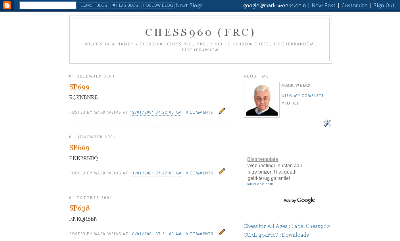
Not much to write home about, is it? Here's the same table from the previous post pegged to specific dates. It lists SPs about which I've already written plus a mention of why I used it.
- 2000-01-03: SP002 - BQNNRBKR • An Exercise in Chess960 Positional Thinking • considerations on the first few moves
- 2000-01-25: SP024 - NBQNBRKR • A Followup, an Error, and an Insight • a position which might be much better for White
- 2000-02-04: SP034 - BNNQRBKR • How Top Players Treat the Same Chess960 Position • also SP919 RKBRQNNB: (like SP034, but with pieces in reverse order); 10 different sequences of opening moves from the same SP
- 2000-03-01: SP059 - NNRQBKRB • Undefended Pawns in Chess960 Start Positions • three undefended Pawns
- 2000-12-28: SP361 - NRKBBRQN • Pyramids and Dropouts • initial moves explained
- 2001-02-21: SP416 - BBRNQNKR • Chess Engines Don't Always Get It • making a plan for the initial development
- 2001-03-25: SP448 - BBRNNKQR • Chess960 Twins • also SP703, its twin; making a plan for the initial development
- 2001-06-19: SP534 - RNBKQBNR • A Database of Chess960 Start Positions • symmetrical SPs w/ K & Q in the center
- 2001-06-19: SP534 - RNBKQBNR • Chess960 Opening Theory • also SP518; initial moves for the tradtional SP as determined by chess engines
- 2002-02-27: SP787 - BRQKNRNB • Chess960? I'm Hooked! • initial observations on chess960
- 2002-06-20: SP900 - RBBKQRNN • Lesson in Chess960 Opening Patterns • watch out for early blunders
One issue is how to treat posts that discuss twin SPs: link them once or twice? Another is how much material to reference for SP518 (the traditional start position), which comes up frequently for the purpose of comparison.
Note that this structure offers two ways to use posts tied to a specific day. A single day can have an unlimited number of posts (although there might be a practical limit that I'm not aware of) -or- a day can have one running post with separators for different topics related to that day. Also possible is a mix of the two structures.
